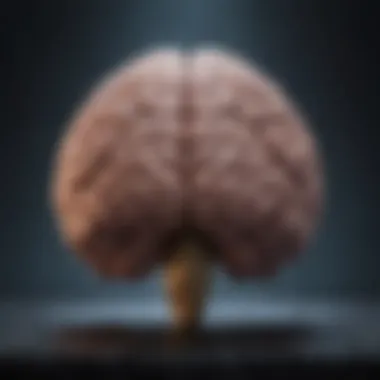Meditation Techniques to Alleviate Anxiety


Intro
In today’s fast-paced world, anxiety has become a common experience. Many individuals seek effective ways to cope with this overwhelming feeling. One approach that stands out is meditation. This article explores the connection between meditation and anxiety relief, highlighting how different techniques can promote emotional well-being.
Benefits of Guided Meditation
Guided meditation is a practice that involves a narrator leading individuals through meditation exercises. This method can be particularly beneficial for those new to meditation, as it provides structure and guidance. The benefits of practicing guided meditation for anxiety are significant.
Mental Health Benefits
Meditation can reshape one's mental landscape. Many studies show that guided meditation can:
- Reduce symptoms of anxiety: Regular practice helps to manage excessive stress and reduce the body's fight-or-flight response, promoting a state of calm.
- Enhance mood: Engaging in meditation can elevate mood and foster a sense of happiness. This mental shift can aid in daily interactions and decision-making.
- Improve focus: By practicing mindfulness, individuals can sharpen their attention, leading to better concentration during stressful situations.
Physical Health Benefits
The advantages of meditation extend beyond the mind. Physiological changes occur that can promote overall health:
- Lower blood pressure: Meditation encourages relaxation, which can reduce high levels of blood pressure, benefiting heart health.
- Boosted immune system: Studies suggest that regular meditation may strengthen the immune response, helping the body combat illness more effectively.
- Reduced muscle tension: Mindful practices can alleviate physical tension held in the body due to anxiety, aiding in overall relaxation.
According to a study published in the Journal of Anxiety Research, mindfulness meditation has remarkable effects on decreasing anxiety levels and improving quality of life.
Techniques for Practicing Guided Meditation
Mastering meditation requires understanding various techniques. For beginners, developing consistency in practice is key. It can be beneficial to start with a few simple techniques.
Mindfulness Practices
Mindfulness focuses on being present and engaged without judgment. Techniques include:
- Body scan: This practice involves focusing on different body parts to release tension and increase awareness.
- Observing thoughts: Paying attention to thoughts without engaging with them can help detach from anxiety triggers.
Breathing Exercises
Breathing exercises are fundamental in meditation, often used to ground oneself. They can be practiced anywhere, such as:
- Deep breathing: Slowly inhaling through the nose and exhaling through the mouth promotes relaxation and reduces stress.
- 4-7-8 breathing: Inhale for four seconds, hold for seven, then exhale for eight. This technique can calm the nervous system effectively.
In summary, meditation is more than a fad; it is a strategic approach to managing anxiety. With guided meditation, individuals can explore various techniques to discover what resonates best with them. The science supporting these practices is compelling, and the potential benefits for mental and physical health are immense. Through understanding and application, meditation can transform one’s experience of anxiety into a manageable aspect of daily life.
Understanding Anxiety
Anxiety is a prevalent issue affecting many individuals today. A comprehensive understanding of anxiety lays the foundation for exploring how meditation can serve as an effective tool for relief. This section delves into various aspects of anxiety, emphasizing its significance in the context of mental wellness. By recognizing the definitions, types, and causes of anxiety, one can better appreciate the role meditation can play in managing stress and enhancing emotional health.
Definition and Types of Anxiety
Anxiety, in a clinical sense, refers to a state of excessive unease or apprehension. It is not merely about feeling nervous before a presentation or uncertain about life choices. Rather, it encompasses various mental health disorders. Among these, general anxiety disorder, social anxiety disorder, and panic disorder are the most frequently recognized categories. Each type brings its own unique symptoms, which can range from persistent worrying to physical manifestations like increased heart rate or sweating. Understanding these distinctions is crucial for tailoring meditation practices to specifically address the type of anxiety one may experience.
Catch and Release: Causes of Anxiety
The origins of anxiety are multifaceted. Common triggers include environmental factors, biological predispositions, and past experiences. Stressful life events, such as job loss or personal trauma, can serve as catalysts for anxiety episodes. Likewise, genetic factors may predispose individuals to anxiety disorders. Recognizing these causes provides insight into the fundamental nature of anxiety, helping individuals identify triggers and patterns in their own lives. This awareness can enhance the effectiveness of mindfulness practices by promoting a deeper understanding of one’s mental state.


The Physiological Impact of Anxiety
Anxiety manifests not only in the mind but also physically. The body responds to stress through various biological pathways, including the release of adrenaline and cortisol. These hormones prepare the body for a fight-or-flight response, yet chronic anxiety can lead to detrimental health issues. Stomach problems, headaches, and difficulty sleeping are but a few examples of how anxiety can manifest physically.
Developing a keen awareness of these symptoms is essential, as it informs how meditation techniques can be employed to calm the body and mind. Through practices focusing on breath and relaxation, one can begin to foster a healthier response to these physiological impacts.
The Psychological Dimension of Anxiety
Psychologically, anxiety can take a toll on one’s self-esteem and overall mental well-being. It can lead to a cycle of negative thinking, where fear and doubt perpetuate feelings of helplessness. Understanding the psychological implications of anxiety is vital for individuals seeking relief. Meditation encourages a shift in perspective, allowing for the observation of thoughts without judgment. By integrating mindfulness and self-reflection, meditation can initiate a transformative process toward emotional resilience.
The connection between anxiety and meditation is not just theoretical but grounded in the need for overcoming mental blocks for a fulfilled life.
Meditation: An Overview
Meditation holds significant importance in understanding how to manage anxiety. As a practice, it provides tools that enhance mental clarity, emotional resilience, and overall well-being. Throughout this article, we explore the diverse elements of meditation, including its history, various techniques, and how it integrates into daily life. This exploration underscores meditation not just as a passive activity but as an active way to engage with one's thoughts, emotions, and ultimately, anxiety.
What is Meditation?
Meditation is a practice that involves focused attention and awareness to achieve mental clarity and emotional stability. Essentially, it is about finding a quiet space in your mind. It can involve various techniques, such as concentration on a specific object or the observation of one's thoughts. The goal is often to reach a state of relaxation or heightened awareness. The practice, while simple in concept, can yield profound benefits for those struggling with anxiety.
Historical Context of Meditation Practices
Meditation has roots in various cultures and spiritual traditions. Initially, it began with ancient religious practices in India, approximately 5,000 years ago. The earliest references to meditation can be found in the Vedic texts where it served a spiritual purpose. Over time, different cultures adopted their own styles of meditation. For instance, Buddhism emphasized mindfulness and awareness as a path to enlightenment. Understanding this historical context showcases how meditation evolved beyond spiritual practices into a widely recognized method for mental health benefits.
Different Types of Meditation Techniques
Mindfulness Meditation
Mindfulness meditation centers around the practice of being present in the moment. It encourages individuals to observe their thoughts and feelings without judgment. This technique is beneficial for those dealing with anxiety as it cultivates a non-reactive stance towards thoughts that might otherwise escalate anxiety. A key characteristic of mindfulness meditation is its accessibility. You can practice it anywhere and at any time. Its unique feature of developing awareness helps individuals realize that thoughts are transient, which can reduce the intensity of anxiety. However, challenges can arise as it requires practice and patience to master.
Transcendental Meditation
Transcendental Meditation is characterized by the use of a mantra, a specific word or sound repeated silently. This technique serves to settle the practitioner into a state of profound rest and mental clarity. It is a popular choice among those with anxiety due to its structured approach। The practice requires only 20 minutes of daily meditation, making it easy to integrate into a busy lifestyle. Its unique feature lies in its simplicity and effectiveness, providing immediate stress relief. However, beginners might find it challenging to find the correct mantra without proper guidance.
Guided Visualization
Guided Visualization involves the use of mental images to elicit a calm response and relaxation. In this technique, practitioners visualize peaceful scenes or scenarios under the guidance of a facilitator or a recording. This method is beneficial for anxiety relief as it encourages individuals to focus on positive imagery. The key characteristic is its engaging format, which can be especially helpful for those who struggle with traditional forms of meditation. Furthermore, its suitability for beginner meditators may be seen as an advantage. Disadvantages may include the reliance on external guidance, which might not always be available.
Body Scan Techniques
Body Scan Techniques involve systematically focusing attention on different parts of the body, often from toes to head. This technique promotes bodily awareness and can help to identify areas of tension. It is useful for understanding how anxiety manifests physically in one’s body. A central characteristic is its focus on bodily sensations and relaxation. The advantages include how grounding it can feel when addressing anxiety. However, diving into bodily awareness might be overwhelming for some, especially those who are new to meditation practices.
The Role of Breath in Meditation
Breath plays a crucial role in meditation. It serves as an anchor that brings practitioners back to the present moment when distractions arise. Deep, rhythmic breathing can trigger the body's relaxation response, which can help calm anxiety. By focusing on breathing patterns, individuals can create a sense of stability and control that translates into emotional regulation. Hence, understanding breath control is fundamental to unlocking the full potential of meditation practices in managing anxiety.
The Intersection of Meditation and Anxiety
Understanding the intersection of meditation and anxiety reveals significant elements of how these two concepts interact. The modern world presents many challenges that can lead to increased anxiety levels. Meditation, with its focus on mindfulness and awareness, offers strategic benefits for individuals grappling with this issue. It provides tools for self-regulation and emotional resilience, becoming a potential lifeline for those in distress.
How Meditation Addresses Anxiety Symptoms


Meditation works at several levels to alleviate anxiety symptoms. First, it encourages a pause in the constant stream of negative thoughts. This pause allows individuals to observe their feelings without immediate reaction. The practice helps ground the mind, shifting focus from worries to the present moment. This shift can create a sense of calm.
Additionally, meditation techniques, such as mindfulness and deep breathing, engage the body's relaxation response. This physiological change can lower heart rate and reduce stress levels. By practicing regularly, individuals can develop a more profound ability to manage situations that might otherwise trigger anxiety.
Neuroscientific Evidence Supporting Meditation for Anxiety Relief
Neuroscientific studies provide compelling evidence of meditation's effectiveness in reducing anxiety. Research shows that regular meditation can alter brain structures related to emotional regulation. For example, the right anterior insula, which plays a role in anxiety processing, may exhibit decreased activity when one meditates. Furthermore, meditation can increase cortical thickness in areas responsible for executive function, essential for managing anxious thoughts.
"Meditation enhances awareness of the present moment, which can lead to a significant reduction in anxiety symptoms."
Studies such as those published in Psychological Science highlight the ability of mindfulness meditation to lower general anxiety levels. Participants exhibited significant improvements in both subjective well-being and physiological markers of anxiety after consistent practice.
Case Studies: Success Stories
Several case studies illustrate meditation's impact on reducing anxiety. For instance, a young woman suffering from generalized anxiety disorder found that adopting a daily mindfulness practice helped her decrease panic attacks significantly. Through focused breathing and visualization, she learned to manage her reactions to stressors effectively.
Another compelling story comes from a veteran dealing with PTSD. After integrating meditation into his routine, his anxiety levels dropped, providing him with tools to cope with triggers. These narratives underscore meditation's potential as a supportive practice for individuals facing different types of anxiety.
Limitations of Meditation for Anxiety Management
Despite the numerous benefits, it is essential to acknowledge the limitations of meditation. Meditation is not a cure-all and may not suit everyone. Some individuals may experience discomfort when attempting to quiet the mind, which could exacerbate feelings of anxiety rather than alleviate them.
Furthermore, meditation should not replace professional treatment for severe anxiety disorders. Those with chronic anxiety conditions should consider therapy or medication in conjunction with meditation. It is crucial to approach meditation as a complementary practice rather than the sole solution.
In summary, the intersection of meditation and anxiety demonstrates a complex relationship filled with potential. While meditation serves as an effective tool for many, it is vital to recognize individual differences and manage expectations accordingly.
Practical Application: Incorporating Meditation into Daily Life
Incorporating meditation into daily life is essential for individuals seeking to manage anxiety effectively. It is not solely the act of meditating but also about making it a consistent part of one’s routine. This section will explore various aspects of practical meditation, highlighting the importance of creating the right environment, establishing a habit, using guided resources, and adapting practices to individual needs. Each element plays a critical role in ensuring that meditation becomes a valuable tool for anxiety relief.
Creating a Meditation Space
A designated meditation space can significantly enhance one's practice. This space should be quiet and free from distractions. It doesn’t have to be elaborate; even a small corner with minimal setup can suffice. Incorporate elements that promote calmness, such as soft lighting, comfortable seating, and perhaps some plants. Consider adding items that inspire your meditative practice. For some, this might include calming sounds or visually appealing artwork. This environment becomes associated with peace, making it easier to transition into a meditative state.
Establishing a Routine
Routine is key to making meditation a lasting part of your life. Find a specific time that works best for you, whether early in the morning or just before bed. This consistency creates a habit, allowing your mind to become conditioned for meditation. Start with shorter sessions, perhaps five to ten minutes, and gradually increase the length. Keeping a journal to track your progress can also provide motivation and accountability. The more regular the practice, the more likely it is to yield positive outcomes regarding anxiety management.
Utilizing Guided Meditations
For those new to meditation, guided meditations can be particularly helpful. They provide direction and structure, alleviating the common uncertainty that often accompanies self-directed practice. Numerous resources exist, both free and paid, which allow access to various guided meditations. Mobile apps like Headspace or Calm have a range of options catering to different needs. Listening to experienced guides helps in developing deeper focus and can clarify techniques such as mindfulness or body scan practices. Use these resources regularly until you feel confident enough to explore unscripted meditation.
Adjusting Techniques to Suit Personal Needs
Meditation is not a one-size-fits-all practice. It is important to tailor techniques to fit your preferences and lifestyle. Some may find mindfulness meditation resonant, while others might prefer more active forms such as walking meditation. Experiment with different styles, paying attention to how each affects your anxiety levels. Adjustments could include the duration of meditation, the posture you use, or even the type of meditation you practice. Flexibility in approach allows individuals to maintain engagement and derive maximum benefit from their practice.
"The journey of a thousand miles begins with one step." – Lao Tzu
Integrating meditation into daily life demands intentionality and effort. When done consistently, it can yield substantial improvements in mental well-being.
By taking time to create a conducive meditation space, establishing a routine, utilizing available resources, and personalizing techniques, one can effectively combat anxiety. Each element enhances the experience and fosters a deeper connection to the practice.


Resources for Further Exploration
Understanding the intricate relationship between meditation and anxiety requires not just theoretical knowledge but also practical tools for incorporation into daily life. Resources such as books, mobile apps, online communities, and workshops provide valuable avenues for deepening understanding and enhancing practice. The following sections will delineate each resource type, highlighting the benefits and considerations for individuals seeking mental wellness solutions through meditation.
Books on Meditation and Mental Health
Books serve as foundational texts for those wanting to learn about meditation and its effects on mental health. There are numerous titles that explore both the theory and practical aspects of meditation. A well-curated reading list can offer insights ranging from beginner techniques to advanced practices. Noteworthy authors in this domain include Jon Kabat-Zinn and Thich Nhat Hanh. These texts often present scientific research alongside personal narratives, making them accessible and relatable.
- The Miracle of Mindfulness by Thich Nhat Hanh
- Wherever You Go, There You Are by Jon Kabat-Zinn
- Radical Acceptance by Tara Brach
Each book provides unique perspectives on integrating mindfulness into daily existence, helping readers cultivate a deeper connection with themselves amidst anxiety.
Mobile Apps for Guided Meditation
The rise of technology has made meditation more accessible than ever. Various mobile apps offer guided meditation sessions that cater to different needs and backgrounds. Applications such as Headspace and Calm provide structured programs that ease users into practices, making them ideal for novices. These apps often feature resources on stress management and anxiety relief, offering specialized courses focusing on mental wellness.
- Headspace: This app provides a user-friendly interface with guided sessions ranging from short to extended practices.
- Calm: Known for its soothing soundscapes and guided meditations, this app is highly rated for relaxation.
Using these apps can help establish a routine and allow users to explore diverse techniques that fit their lifestyle and preferences.
Online Communities and Forums
Online platforms such as Reddit offer vibrant forums where users can share experiences, challenges, and successes related to meditation and anxiety. Engaging with others in these communities fosters a sense of belonging and reduces feelings of isolation. Additionally, forums can serve as a valuable source of information on various techniques and methods. One can learn from others and discover new approaches that have worked for peers.
"Forums provide not just knowledge but shared human experience. They can be a support network during tough moments."
Participating in discussions can enhance motivation and increase dedication to a meditation practice.
Workshops and Retreats
Attending workshops or retreats can provide immersive experiences that deepen one’s understanding of meditation. These events often involve expert guidance from seasoned practitioners who can offer personalized support. Workshops typically accommodate various skill levels, making them suitable for everyone, from beginners to advanced meditators.
- Local Workshops: Many community centers or yoga studios organize regular meditation workshops.
- Retreats: These can range from day-long events to week-long immersions in tranquil settings, ideal for disconnecting from daily stressors.
Participating in these settings allows for focused practice and can lead to significant personal growth and mental clarity.
By utilizing the resources outlined above, individuals can create a comprehensive framework to explore meditation, ultimately aiding in the management and alleviation of anxiety. Engaging with diverse materials and communities significantly enhances the journey towards mental wellness.
Final Thoughts
Meditation serves as a powerful tool in the ongoing battle against anxiety. It is essential to understand how it can provide both immediate relief and long-term benefits. The cultivation of mindfulness through meditation not only helps in managing anxiety symptoms but also fosters a greater sense of overall well-being.
The Path to Mindfulness
Mindfulness is a state of active, open attention. It is about observing one's thoughts and feelings without judgment. Engaging in mindfulness promotes self-awareness. Practicing mindfulness helps individuals detach from overwhelming thoughts. This detachment is vital for reducing anxiety's grip on daily life.
To walk the path of mindfulness, one may start with simple techniques. Breathing exercises serve as a foundation; focusing on each inhale and exhale can ground one in the present moment. Prioritize creating a ritual of mindfulness, whether through mindful eating, walking, or daily routine. Each moment offers an opportunity to practice being present, which in turn reduces anxiety.
Continuing Journey Beyond Meditation
The benefits of meditation are not limited to when one is on the mat or sitting in silence. The real challenge lies in integrating its principles into everyday experiences. Carrying the essence of meditation into interactions, decisions, and emotional responses is crucial for lasting change.
Moreover, maintaining a continued practice is essential for reinforcing its benefits. This can mean exploring new techniques, attending workshops, or engaging with communities that focus on mindfulness.
Ultimately, the journey is ongoing. Each person's path is unique, shaped by individual experiences and needs. Those seeking mental wellness should view meditation as part of a broader lifestyle approach to managing anxiety. Through this journey, individuals cultivate resilience and develop tools to face life’s challenges more effectively.
"Meditation is not about stopping thoughts, but recognizing that you are more than your thoughts and feelings."
This recognition is powerful. As individuals realize they can observe without attachment, they take significant strides toward alleviating anxiety.







